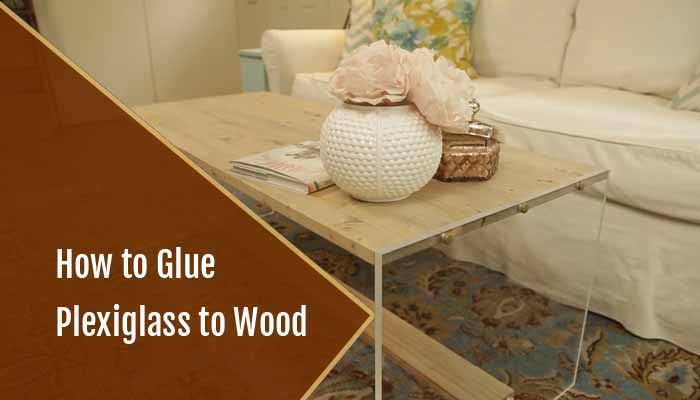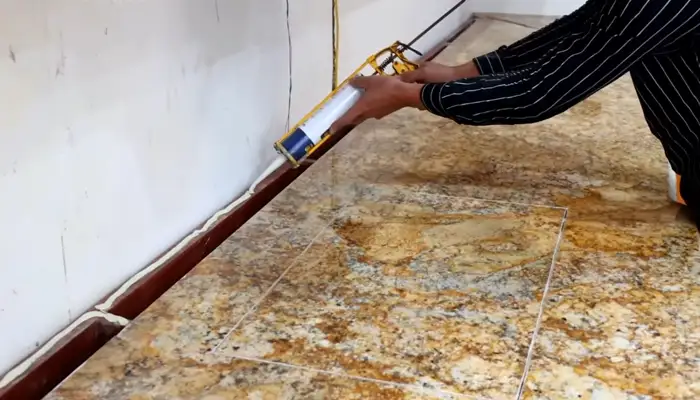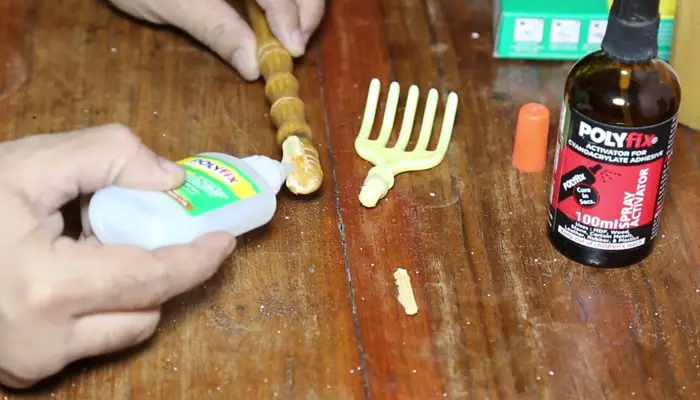WoodenuKnow.com is a participant in the Amazon Services LLC Associates Program, an affiliate advertising program designed to provide a means for sites to earn advertising fees by advertising and linking to Amazon.com and may earn from qualifying purchases.
Have you ever wanted to add a layer of protection and style to your wood?
One way is by gluing plexiglass onto the wood. Plexiglass is strong, durable, and lightweight. It can be glued to wood with contact cement or another adhesive that has been designed for bonding plastics. Make sure the surfaces are clean and free of dust and dirt before applying the adhesive.
The best part about this task is it’s easy. You don’t need any special tools or skills to glue plexiglass to wood, just some time on your hands (and maybe a friend).
Let’s take a look at the step-by-step guide:
Step by Step Guide on How to Glue Plexiglass to Wood
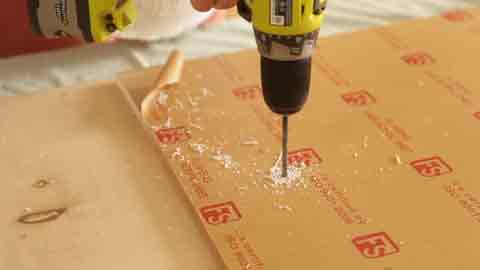
The following steps will give you the proper instructions on how to glue plexiglass to wood.
Step 01: Measure and Cut the Plexiglass to the Size You Need
To cut the plexiglass and glue it to the wood first, you’ll need a straightedge and some cutting implement. You’ll also want a wood that is flat and smooth to work on.
Measure and mark the cutting line along your straightedge. This line should be as precise as possible, so make sure it’s well-marked and placed correctly before cutting.
Make sure you are cutting against the wood table, not with it, or ridges will result in your cut. An old-style utility knife can work for this project, but you may find a pencil sharpener or an X-Acto cutter more useful for this task.
Cutaway from yourself along the line while applying light force. Please don’t rush through the cut, or it may end up rough and jagged.
Keep your knife clean by wiping it with a soft cloth or paper towel to avoid any residue from getting onto the Plexiglas.
Use sandpaper (medium grit) to smooth out the edges of your cut plexiglass before attaching them. This will allow you to get rid of sharp points and edges that might otherwise damage your Plexiglass or get in the way of a good seal.
Step 02: Clean the Wood of Both Pieces to be Glued
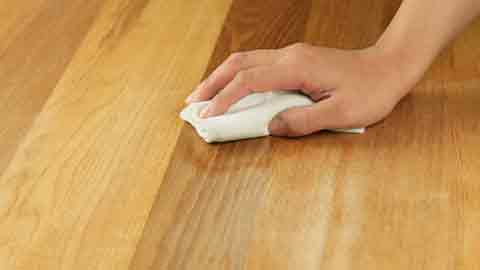
To glue plexiglass to wood, The surfaces need to be clean for the glue to work. Use a scouring pad to remove any dirt, grease, or oils from the exteriors before using the glue.
Clean the wood of both pieces and let them dry before applying the adhesive.
This is important if you are working with plexiglass and wood because it will not stick to dirty surfaces.
Step 03: Making Sure About the Lining
Make sure that each layer is lined up correctly before doing so. Press firmly along the entire facade of your plexiglass to wood.
Pay close attention to how much adhesive and cement you have used if any additional layers need to be added.
Allow it to dry for the amount of time stated in the instructions.
Wipe down the outside of your project with a warm, wet cloth to remove any debris or dirt that may have gotten onto it during assembly.
Step 04: Apply Cement or Adhesive
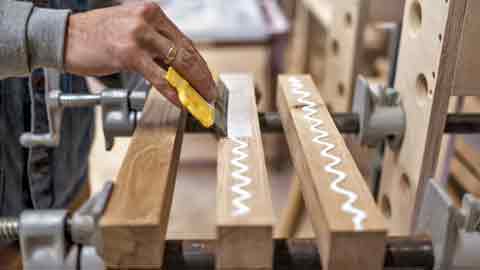
Before applying any cement or adhesive, make sure that you have enough for the entire project. Different adhesives have different instructions on how much material is necessary for projects like this. Please check directions on your specific product for the best results.
Apply a generous amount of contact cement or another appropriate link agent and spread it evenly over one exterior of your plexiglass. Be careful not to get any on the other facade because this will end up in a mess when you put them together.
If possible, let the adhesive sit for five minutes before applying the Plexiglas because it may take some time to adhere completely. If you are working with cement, follow instructions for coverage and drying time. Cement usually takes at least an hour to set completely.
Step 05: Attach the Plexiglass to the Wood
Bring your plexiglass together, making sure that both exteriors are lined up correctly before doing so. Press firmly along the entire cover of your plexiglass.
Apply pressure to the entire cover of your top Plexiglas so that it sticks firmly to the bottom layer. Use clamps or rubber bands to hold the pieces together if you need to. This is best done after the adhesives have been set for a few hours or more to ensure a good bond.
Step 06: Clean Up Any Leftover Adhesive
Once you have cleaned off all of the excess cement or adhesive, take a cloth or paper towel and make sure there are no leftover pieces left on either layer. This will keep your task looking clean and professional.
Step 07: Allow It to Dry for the Amount of Time Stated in the Instructions
Most contact cement needs to be set for twenty-four hours before being handled or used, so make sure you allow for proper drying time between each step.
Allow your plexiglass design to sit undisturbed until it has dried completely before using it for anything. If you move it before the glue has dried, the layers could separate and ruin everything you’ve worked so hard on.
Step 08: Use Screws to Fix it to the Wooden Frame
Attach two or three screws straight to the wooden frame following the natural curve, and the plexiglass will be held tightly. After you are done, you can use a grinder to remove any excess from the screw heads.
This is a good method to fixing your plexiglass to the wooden frame that will make you feel easy and convenient.
Step 09: Use an Acrylic Sealant or Paint to Finish The Look
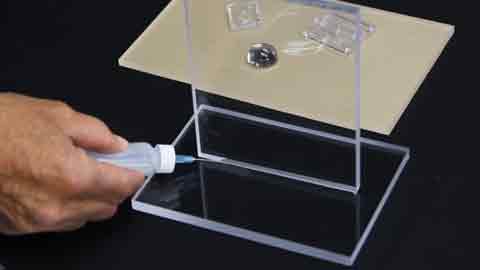
write about If you are gluing plexiglass onto wood, use an acrylic sealant or paint on top of the glass after it has dried completely to protect against moisture damage from spills and condensation
You can seal the plexiglass with an acrylic sealant or paint to protect it from moisture damage caused by spills or condensation. This is especially important if you are planning to use it outdoors. Paint or sealant will protect your plexiglass from moisture and also make it look cleaner and thicker.
Paint or sealant can be applied with a brush in even strokes across the entire exterior, painting from side to side. Wipe off any excess paint or sealant with a clean cloth. Allow it to dry completely before handling the plexiglass or using it for its intended purpose.
Try using high-gloss paint if you want your glassy facade to shine and look professional. This type of paint is also easier to wipe off without leaving behind streaks or thin sections of paint in certain areas.
For a more textured look, try using paint with a flat finish or even an acrylic matte sealant. Make sure you put on enough so that the plexiglass is completely protected from liquids and condensation. If the glass is already cold, it can cool down the layer of liquid above it, which will cause water to condense and become trapped. The sealant will prevent this from happening.
Additional Tips about Glueing Plexiglass to Wood
Plexiglass Glue with Acrylic Adhesive
To glue plexiglass to wood, another alternative way is to use acrylic glue. It can be glued with contact cement or another glue designed for synthetics. As usual, first, make sure the exteriors are clean of dirt and dust. You can also use a primer before gluing plexiglass to wood.
Apply the glue on both exteriors and wait until it becomes tacky. Once it gets tacky, align the two exteriors together and apply pressure.
To properly glue plexiglass to wood, You should leave the two pieces of Plexiglass alone for a couple of hours until they become secure with each other. If you attach the Plexiglass with a wood frame, you can secure it to the wooden frame using screws.
You might need to use clamps while gluing plexiglass to wood and ensure that any form of bubbles is gone from the surface. After a couple of hours, remove the clamps and allow the glue and plexiglass to dry.
Plexiglass Glue with Epoxy Glue
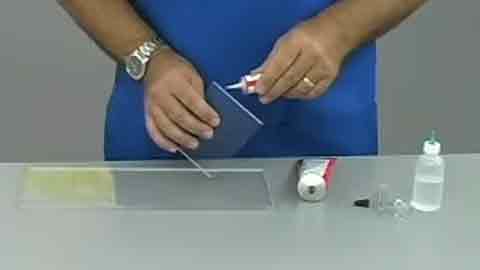
If you’re not sure if your adhesives will work for joining Plexiglass to wood, try using epoxy glue. It’s a two-part adhesive that needs a mixing ratio of one part resin and one part hardener.
Mix it in equal parts and apply it to both sides. Let it sit for about ten minutes before using the Plexiglass to the wood surface. The two parts generally need at least thirty minutes’ drying time before clamping or handling.
Acrylic Silicone
Another glue that you can use for joining Plexiglass to wood is acrylic silicone. It’s a rubber-based and two-part glue that needs a mixing ratio of one part resin and one part coating emulsion.
The mixture should be mixed with an equal portion of each component in a disposable container. Align the surfaces together less than ninety degrees and apply pressure. Let the glue set for at least an hour before handling it.
The time needed for drying depends on the thickness of the Plexiglass piece glued to the wood. If it’s thicker than 1/8″, it will take around 24 hours to dry completely. For pieces under 1/8″ in thickness, it will take about 8 hours to dry.
When removing the Plexiglass, it is difficult to get the glue out of the wood. In some cases, a solvent will be required.
Plexiglass Glue with Acetone
Acetone is a commonly used solvent in glues because of its ability to soften synthetic bonds and dissolve adhesives. Acetone can be evaporated and flushed out of the wood without leaving any trace.
You can use a synthetic scraper to remove excess glue that settled onto the Plexiglas but still ensure its texture stays intact. Once you’re done with it, leave it open to the air for about 12 hours before using it.
Hot-Melt Glue With Contact Cement
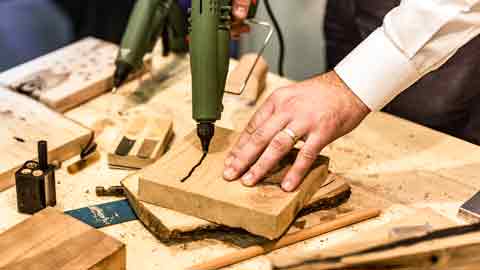
In contact cement, the glue is applied to one surface, and then a protective coating is applied on top of it. This way, when the surfaces are brought together, the protective coating acts as a bit of an adhesive.
Often, this contact cement may not be sufficient in bonding plexiglass to wood. It also doesn’t allow for adjustments or repositioning after it has dried. If you want something that will let you adjust your Plexiglass and its placement once you have pasted it on, try using hot-melt glue.
Hot-melt glue is designed specifically for bonding plastic and wood materials. It can be bought at any hardware store for about $9 per pound.
This kind of glue is high-quality and has a long lifespan. It also adheres to most plastics, so it’s easy for you to find replacements if you need to replace them.
You can use hot-melt glue for any Plexiglass application on wood. If you want your Plexiglass pieces to be transparent, make sure that the glue is transparent as well.
For bonding plexiglass to wood, it will take about 24 hours for the glue to dry completely after applying it.
Hot-melt glue with contact cement
One of the most common questions about hot-melt glue is its comparison when used in conjunction with contact cement. For this purpose, you.
Some FAQs About How to Glue Plexiglass to Wood
Here are some common FAQs you might want to know
1. What is the Best Type of Adhesive?
Answer: One option that many people find works well with wood is contact cement. It has an easy application, works quickly, and dries clear and harder than other adhesives.
You can also use a clean coating sealant, which will protect the wood and provide an invisible bond to the glass-like surface of the plexiglass.
2. Which Side Should be Facing up When Gluing Plexiglass to Wood?
Answer: The side of the Plexiglass that will be facing up (aka the outer surface) should be anchored in place first.
3. Is it Ok to Use Other Types of Glue to Wood?
Answer: I guess it would depend on what you are using the glue for. There are times when say, a rubber cement might be more appropriate than the usual household glue (Example: if you have to bond two pieces of latex together).
4. What is the Difference Between Plexiglass and Acrylic?
Answer: Plexiglass and acrylic Both can be used to make plastic windows, signs, or other items. An acrylic is a form of synthetic resin that has less clarity than glass. It also tends to show fingerprints much more easily.
Last Thoughts
Last but not least, we hope all the information above helps you decide which steps to take, and we hope this article will help you learn how to glue Plexiglass to Wood.
Don’t forget to share your experience with us about gluing plexiglass to wood. We will be delighted to hear from you.

